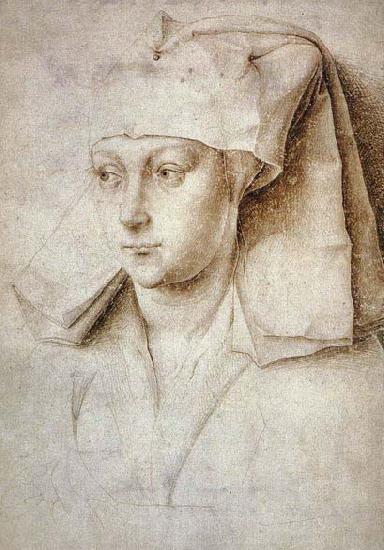New Crafts International LLC Europe
WEYDEN, Rogier van der
Portrait of a Young Woman
Pintura Identificación: 63866
1440 Silverpoint on prepared paper, 166 x 116 mm British Museum, London The finest of the drawings ascribed to Rogier is the Portrait of a Young Woman. In its freshness of observation and lively expression the drawing comes closest to the painted portrait of another young woman (Staatliche Museen, Berlin), although in contrast to that painting - probably the earliest of the independent portraits by Rogier still extant - the draftsman has modeled the face with much greater plasticity, using light and shade to make shapes like the eyelids appear more rounded and fleshier. This factor in turn links the drawing closely to a portrait of a woman ascribed to the Master of Fl?malle, now in the National Gallery, London, and to the faces in Rogier's earlier Deposition (Prado, Madrid). The strong, bright reflections on the shaded areas of the sitter's throat and cheeks also adopt a method frequently used by Jan van Eyck to heighten the sense of three-dimensionality. By comparison with the chiaroscuro and the powerful three-dimensional style of the drawing, the painted face of the young woman in the portrait appear generally more linear - paradoxically, one might almost say more like a drawing. The draftsman's intention of placing several strong contrasts of light and shade side by side also matches the effects in the Deposition. Like the shaded side of the head of the Virgin, the right-hand side of the portrait drawing shows the alternation of light and very dark areas, and the artist has even shaded the headdress heavily next to the area of reflected light on the sitter's jaw line just below her ear, though this effect is illogical, since if the head-dress is to reflect light it ought to be lit there itself. However, the darkness in the outer area of the drawing, emphasizing the fold at the back of the head-dress, is a genuinely distinctive feature, producing the effect of heavy shadow. There are no such heavy shadows in any painted portrait by Rogier; this pictorial device, creating a sense of space around the figure, first appears in painting around the middle of the century in works by the artist Petrus Christus, who was active in Bruges. Here the draftsman may have created the shadows before drawing the sitter herself, or he may have placed them there to make the back of the headdress retreat into the background - an effect that would also be achieved by the uniform dark ground of a painted portrait. The immediacy of this portrait gives the impression that it was drawn from life. Such an impression is further supported by the fact that only the head and the complicated head-dress are executed in detail, while the upper part of the sitter's body is only lightly indicated; her dress with its patterns of folds could be added later, and leaving it out while the woman herself was being portrayed would have spared her the tedium of sitting for the artist. Such details could easily enough be copied from a painting, but the visible part of the woman's body appears rather awkwardly executed. The right hand on the edge of the picture is particularly jarring, and does not quite connect up anatomically with her shoulder. It is complex in structure, but only half shown, and its clear outline does not make it look like a study from nature. Perhaps the artist completed the lower areas of the portrait later, using a work already in his stock, and experimenting with the composition of his planned painting. All Early Netherlandish portraits were certainly based on drawings from life, for the long process of painting would not have allowed the artist to work from a living model. The Portrait of a Young Woman, outstanding as both a drawing and a portrait, must be one of the very few examples of this genre to have been preserved. Since over and beyond these qualities, the drawing shows similarities with Rogier's painted portraits in its presentation, and with his Deposition in the manner of depicting a head, it could well be by his own hand. It was probably done quite close to the time of the great altarpiece for the Archers of Leuven, while the other (painted) Portrait of a Young Woman must have been executed rather later.Artist:WEYDEN, Rogier van der Title: Portrait of a Young Woman Painted in 1401-1450 , Flemish - - graphics : portrait

Vea nuestra galería en Suecia







